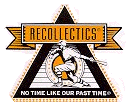
Nothing Tacky About the Value of Press Pins
by Scott Kelhofer
If your definition of the "perfect" collectible is something that's very limited in nature and maintains a high value, then press pins are something you should consider adding to your collection. Press pins have been around for close to 90 years and for most of that time, the pins served as an ID badge for members of the media covering a major sporting event.
Today's media are granted more elaborate credentials than a metal pin in order to guarantee their access to major sporting events, but the tradition of the press pin lives on, even though it's more of a commemorative item than a required one.
The roots of the press pin extend back to the early 1910s, New York Giants manager John McGraw had quite a loyal legion of friends who liked to attend Giants games and he hated to say no to any of his friends who wanted free access to the games.
So McGraw arranged passes for his friends to get into the stadium. The only problem was that his friends would make themselves comfortable in the press box while the working media was down on the field interviewing players before the game. When the media would come back to their seats, they found McGraw's friends taking advantage of some of the amenities available in the press box.
To avoid the intrusion of the general public into the media's working area, the newly-formed Baseball Writers of America group issued specially-designed lapel pins that would be required of anyone attempting to gain access to the press box area.
Since then, press pins have been produced for virtually every World Series and All-Star Game in baseball, as well as every Super Bowl. In addition, press pins are known to exist for some Stanley Cup, Finals, NBA Championships, Indy 500 races and Hall of Fame induction ceremonies.
One of the nation's leading press pin collectors and dealers is Daniel Lovegrove of Recollectics, located in Darien, Conn. Lovegrove says he was first introduced to press pins by a friend more than 20 years ago, and he's been hooked on them ever since.
"The only way you can get one is to be a media member or front office employee of the team," Lovegrove explained. "They only made between 2,000- 4,000 pins for the '96 World a Series. In the 1920s, they made only a few hundred for each team."
Because of the fashion in which press pins are distributed, only a few ever seem to make their way into the collector market. When they do, prices for the items, reflect their scarcity.
Older World Series pins - those from the 1910s and '20s - can easily sell for over 1,000 each. Pins from the most recent World Series and Super Bowl games usually start out in the $150 range. For $150-300, collectors can purchase a wide variety of press pins issued in all sports over the past 25 years.
One of the most popular types of press pins among collectors are known as "phantom" pins.
"Press pins take anywhere from six to eight weeks to be created," Lovegrove said, "So a lot of baseball teams would have to have press pins made in case their club made it to the World Series."
So while the 1935 St. Louis Cardinals, the 1984 Chicago Cubs or the 1987 Boston Red Sox never made it to the World Series, there are press pins that were made in case they would have. The '35 Cardinals pin is valued at 550, while the '94 Cubs pin goes for $165 and the '87 Red Sox pin is worth $250.
While phantom pins are often priced higher than standard press pins from the same year, Lovegrove cautions new collectors about jumping into the phantom pin market.
"I always try to discourage people from collecting phantom pins unless the pin is dated because potential phan tom pins can become contemporary, used pins," Lovegrove said. "Some teams have a press pin created that just says something like, 'Cleveland Indians World Series.' If it doesn't get used in 1996, it could still get used the following year or whenever. Some people might spend $250 on a phantom pin, but then the team might make it to the Work Series the next year and then the same pin is only worth $125."
For non-phantom pins, Lovegrove said that scarcity, condition, and the popularity of the teams depicted or the pin play the major factors in determining the value of a press pin. To be considered in Mint condition, pins should be in thier original box (if available) have no scratches or chips, and have the pin post intact on the back.
"Some teams, like the Cubs, had very small press boxes in the old days," Lovegrove said. "So very few pins were originally issued. Pins for the Yankees, Brooklyn Dodgers and Cubs are always good sellers because all of those teams have very loyal following of fans." For more information on press pin collecting, contact Recollectics at (203) 655-7463, or visit the company's web site, at www.recollectics.com.
(Scott Kelnhofer is the managing editor of Sports Cards.)
Sports Cards Magazine and Price Guide - November 1997, Issue #146 Vol. 17, No. 11
Used with permission from Krause Publications (c) 1997, Krause Publications, Inc.